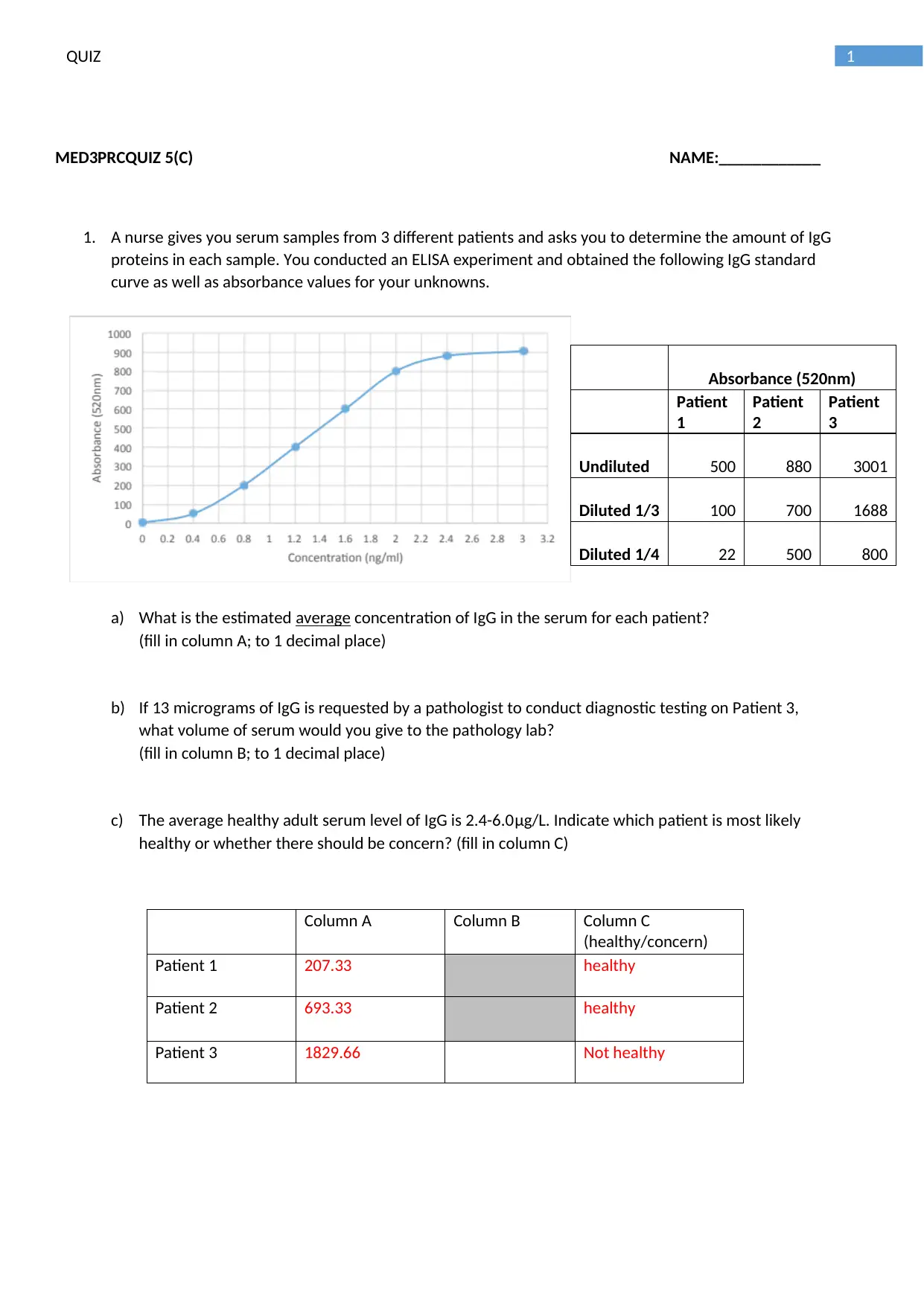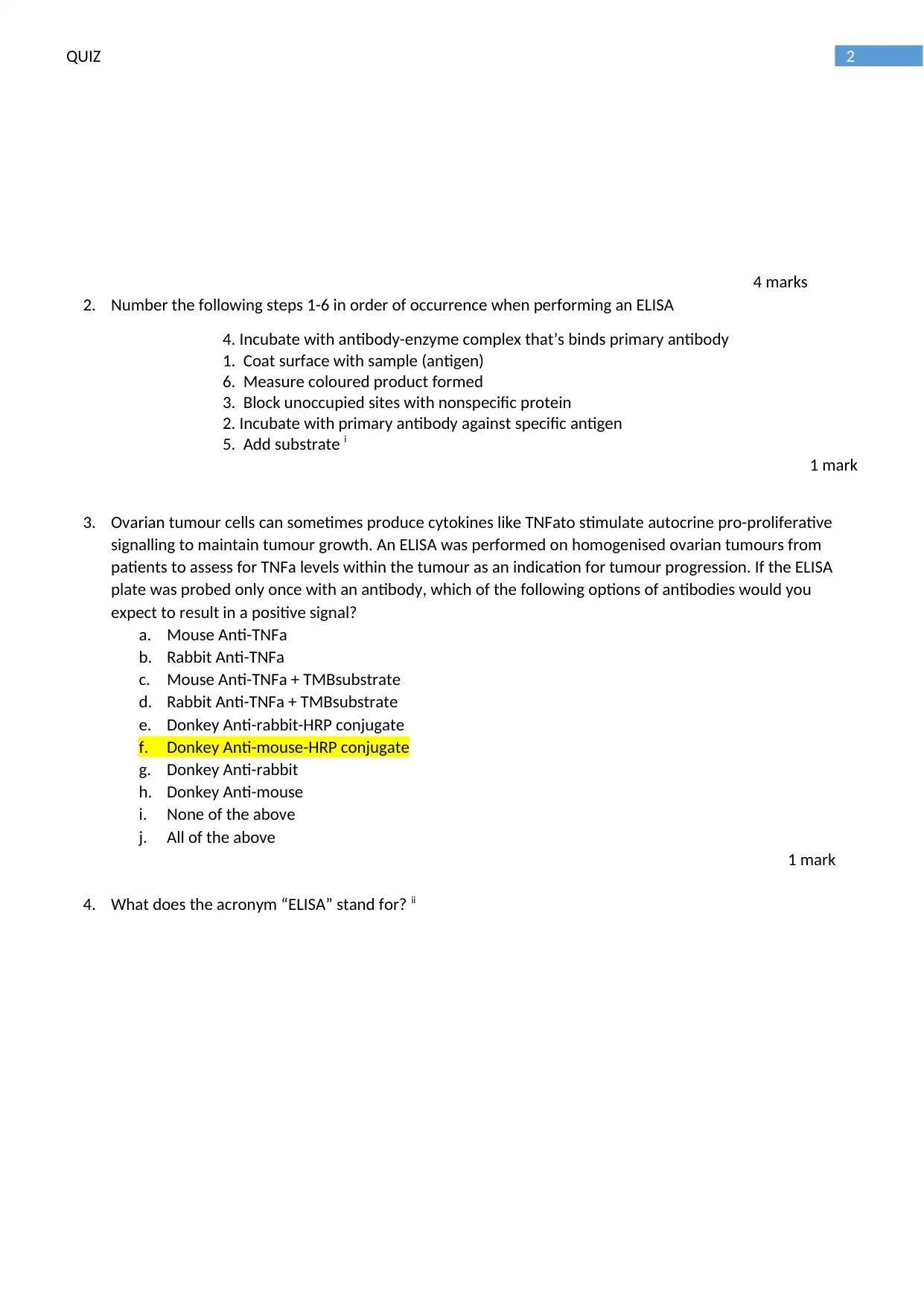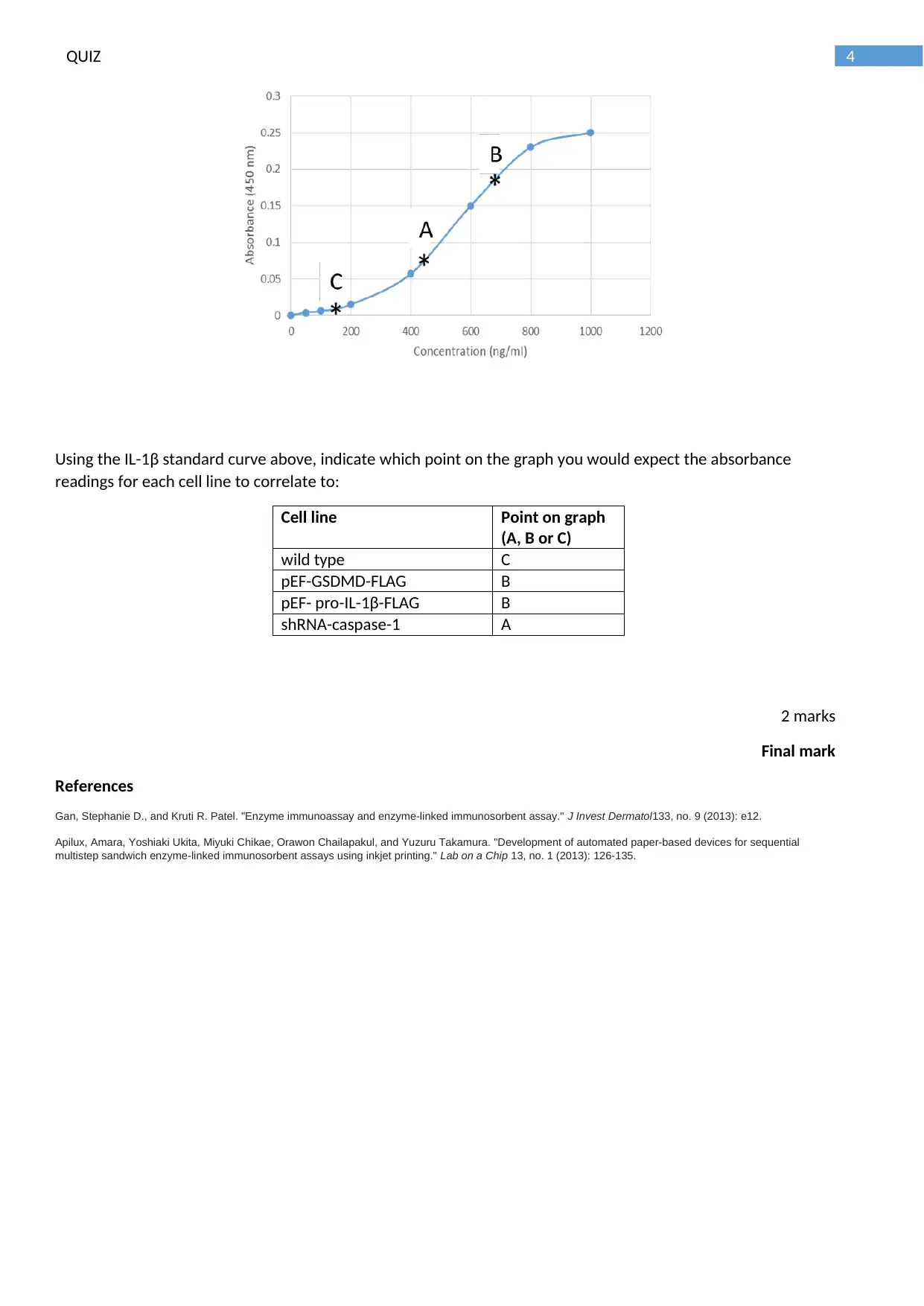MED3PRC Quiz 5(C): ELISA Application and IgG Concentration Analysis
VerifiedAdded on 2023/06/10
|6
|968
|178
Quiz and Exam
AI Summary
This document presents a solved quiz focusing on Enzyme-Linked Immunosorbent Assay (ELISA) and its application in determining IgG concentrations in patient serum samples. The quiz includes questions on calculating IgG concentrations from ELISA data, understanding the ELISA procedure, and interpreting results in the context of patient health. Specifically, it covers calculating average IgG concentrations for three patients based on absorbance values, determining the serum volume needed for diagnostic testing, and assessing patient health based on IgG levels. Additionally, the quiz tests knowledge of the ELISA steps, antibody selection, and the role of cytokines in cellular processes. The solutions provided offer a comprehensive understanding of ELISA principles and their practical applications in clinical diagnostics and research.

Running head: QUIZ
QUIZ
Name of the Student:
Name of the University:
Author Note:
QUIZ
Name of the Student:
Name of the University:
Author Note:
Paraphrase This Document
Need a fresh take? Get an instant paraphrase of this document with our AI Paraphraser

1QUIZ
MED3PRCQUIZ 5(C) NAME:____________
1. A nurse gives you serum samples from 3 different patients and asks you to determine the amount of IgG
proteins in each sample. You conducted an ELISA experiment and obtained the following IgG standard
curve as well as absorbance values for your unknowns.
a) What is the estimated average concentration of IgG in the serum for each patient?
(fill in column A; to 1 decimal place)
b) If 13 micrograms of IgG is requested by a pathologist to conduct diagnostic testing on Patient 3,
what volume of serum would you give to the pathology lab?
(fill in column B; to 1 decimal place)
c) The average healthy adult serum level of IgG is 2.4-6.0μg/L. Indicate which patient is most likely
healthy or whether there should be concern? (fill in column C)
Absorbance (520nm)
Patient
1
Patient
2
Patient
3
Undiluted 500 880 3001
Diluted 1/3 100 700 1688
Diluted 1/4 22 500 800
Column A Column B Column C
(healthy/concern)
Patient 1 207.33 healthy
Patient 2 693.33 healthy
Patient 3 1829.66 Not healthy
MED3PRCQUIZ 5(C) NAME:____________
1. A nurse gives you serum samples from 3 different patients and asks you to determine the amount of IgG
proteins in each sample. You conducted an ELISA experiment and obtained the following IgG standard
curve as well as absorbance values for your unknowns.
a) What is the estimated average concentration of IgG in the serum for each patient?
(fill in column A; to 1 decimal place)
b) If 13 micrograms of IgG is requested by a pathologist to conduct diagnostic testing on Patient 3,
what volume of serum would you give to the pathology lab?
(fill in column B; to 1 decimal place)
c) The average healthy adult serum level of IgG is 2.4-6.0μg/L. Indicate which patient is most likely
healthy or whether there should be concern? (fill in column C)
Absorbance (520nm)
Patient
1
Patient
2
Patient
3
Undiluted 500 880 3001
Diluted 1/3 100 700 1688
Diluted 1/4 22 500 800
Column A Column B Column C
(healthy/concern)
Patient 1 207.33 healthy
Patient 2 693.33 healthy
Patient 3 1829.66 Not healthy

2QUIZ
4 marks
2. Number the following steps 1-6 in order of occurrence when performing an ELISA
4. Incubate with antibody-enzyme complex that’s binds primary antibody
1. Coat surface with sample (antigen)
6. Measure coloured product formed
3. Block unoccupied sites with nonspecific protein
2. Incubate with primary antibody against specific antigen
5. Add substrate i
1 mark
3. Ovarian tumour cells can sometimes produce cytokines like TNFato stimulate autocrine pro-proliferative
signalling to maintain tumour growth. An ELISA was performed on homogenised ovarian tumours from
patients to assess for TNFa levels within the tumour as an indication for tumour progression. If the ELISA
plate was probed only once with an antibody, which of the following options of antibodies would you
expect to result in a positive signal?
a. Mouse Anti-TNFa
b. Rabbit Anti-TNFa
c. Mouse Anti-TNFa + TMBsubstrate
d. Rabbit Anti-TNFa + TMBsubstrate
e. Donkey Anti-rabbit-HRP conjugate
f. Donkey Anti-mouse-HRP conjugate
g. Donkey Anti-rabbit
h. Donkey Anti-mouse
i. None of the above
j. All of the above
1 mark
4. What does the acronym “ELISA” stand for? ii
4 marks
2. Number the following steps 1-6 in order of occurrence when performing an ELISA
4. Incubate with antibody-enzyme complex that’s binds primary antibody
1. Coat surface with sample (antigen)
6. Measure coloured product formed
3. Block unoccupied sites with nonspecific protein
2. Incubate with primary antibody against specific antigen
5. Add substrate i
1 mark
3. Ovarian tumour cells can sometimes produce cytokines like TNFato stimulate autocrine pro-proliferative
signalling to maintain tumour growth. An ELISA was performed on homogenised ovarian tumours from
patients to assess for TNFa levels within the tumour as an indication for tumour progression. If the ELISA
plate was probed only once with an antibody, which of the following options of antibodies would you
expect to result in a positive signal?
a. Mouse Anti-TNFa
b. Rabbit Anti-TNFa
c. Mouse Anti-TNFa + TMBsubstrate
d. Rabbit Anti-TNFa + TMBsubstrate
e. Donkey Anti-rabbit-HRP conjugate
f. Donkey Anti-mouse-HRP conjugate
g. Donkey Anti-rabbit
h. Donkey Anti-mouse
i. None of the above
j. All of the above
1 mark
4. What does the acronym “ELISA” stand for? ii
⊘ This is a preview!⊘
Do you want full access?
Subscribe today to unlock all pages.

Trusted by 1+ million students worldwide

3QUIZ
1 mark
5. The following absorbance values were obtained from an ELISAusing patient tissue samples and
compared to a hypothetical standard curve. These values were of ONE sample that was either
undiluted,diluted 1/3, diluted 1/4, or diluted 1/10. Only 580nm fell onto the linear portion of the curve.
Which of the following absorbance values was derived from the 1/4 diluted sample?
a. 1600nm
b. 330nm
c. 580nm
d. 159nm
1 mark
6. The pro-inflammatory cytokine interleukin-1β (IL-1β) is a key mediator of inflammation and is important
in host defence against microbial infections. IL-1β is synthesised as an inactive pro-IL-1β polypeptide but
upon viral or bacterial infection of the host cell, pro-IL-1β is processed to a mature “active” form (that is,
IL-1β) by caspase-1 (an inflammatory protease). Cellular contents (including mature IL-1β) can then be
released from the cell as a result of activated GSDMD (a pore forming inflammatory protein) forming
pores on the cell membrane. Multiple derivatives of the THP-1 monocyte cell line were treated with
lipopolysaccharide (LPS; a bacteria-like antigen) to activate inflammatory signalling and promote IL-1β
release from the cell (and into the culture media). An ELISA was conducted on undiluted samples and
concentrations of mature IL-1β obtained from the cell culture medium of each of these LPS-treated
cells. The cell lines are listed as follows (pEF=vector backbone; FLAG=sequence to encode FLAG protein;
shRNA=short hairpin RNA plasmid):
- THP-1 wild type
- THP-1 + pEF-GSDMD-FLAG (to over expressGSDMD protein levels)
- THP-1 + pEF-pro-IL-1β-FLAG (to over express pro-IL-1β protein levels)
- THP-1 + shRNA-caspase-1 (to reduce caspase-1 protein expression)
“ELISA” stands for Enzyme linked immunosorbent assay
1 mark
5. The following absorbance values were obtained from an ELISAusing patient tissue samples and
compared to a hypothetical standard curve. These values were of ONE sample that was either
undiluted,diluted 1/3, diluted 1/4, or diluted 1/10. Only 580nm fell onto the linear portion of the curve.
Which of the following absorbance values was derived from the 1/4 diluted sample?
a. 1600nm
b. 330nm
c. 580nm
d. 159nm
1 mark
6. The pro-inflammatory cytokine interleukin-1β (IL-1β) is a key mediator of inflammation and is important
in host defence against microbial infections. IL-1β is synthesised as an inactive pro-IL-1β polypeptide but
upon viral or bacterial infection of the host cell, pro-IL-1β is processed to a mature “active” form (that is,
IL-1β) by caspase-1 (an inflammatory protease). Cellular contents (including mature IL-1β) can then be
released from the cell as a result of activated GSDMD (a pore forming inflammatory protein) forming
pores on the cell membrane. Multiple derivatives of the THP-1 monocyte cell line were treated with
lipopolysaccharide (LPS; a bacteria-like antigen) to activate inflammatory signalling and promote IL-1β
release from the cell (and into the culture media). An ELISA was conducted on undiluted samples and
concentrations of mature IL-1β obtained from the cell culture medium of each of these LPS-treated
cells. The cell lines are listed as follows (pEF=vector backbone; FLAG=sequence to encode FLAG protein;
shRNA=short hairpin RNA plasmid):
- THP-1 wild type
- THP-1 + pEF-GSDMD-FLAG (to over expressGSDMD protein levels)
- THP-1 + pEF-pro-IL-1β-FLAG (to over express pro-IL-1β protein levels)
- THP-1 + shRNA-caspase-1 (to reduce caspase-1 protein expression)
“ELISA” stands for Enzyme linked immunosorbent assay
Paraphrase This Document
Need a fresh take? Get an instant paraphrase of this document with our AI Paraphraser

4QUIZ
Using the IL-1β standard curve above, indicate which point on the graph you would expect the absorbance
readings for each cell line to correlate to:
Cell line Point on graph
(A, B or C)
wild type C
pEF-GSDMD-FLAG B
pEF- pro-IL-1β-FLAG B
shRNA-caspase-1 A
2 marks
Final mark
References
Gan, Stephanie D., and Kruti R. Patel. "Enzyme immunoassay and enzyme-linked immunosorbent assay." J Invest Dermatol133, no. 9 (2013): e12.
Apilux, Amara, Yoshiaki Ukita, Miyuki Chikae, Orawon Chailapakul, and Yuzuru Takamura. "Development of automated paper-based devices for sequential
multistep sandwich enzyme-linked immunosorbent assays using inkjet printing." Lab on a Chip 13, no. 1 (2013): 126-135.
Using the IL-1β standard curve above, indicate which point on the graph you would expect the absorbance
readings for each cell line to correlate to:
Cell line Point on graph
(A, B or C)
wild type C
pEF-GSDMD-FLAG B
pEF- pro-IL-1β-FLAG B
shRNA-caspase-1 A
2 marks
Final mark
References
Gan, Stephanie D., and Kruti R. Patel. "Enzyme immunoassay and enzyme-linked immunosorbent assay." J Invest Dermatol133, no. 9 (2013): e12.
Apilux, Amara, Yoshiaki Ukita, Miyuki Chikae, Orawon Chailapakul, and Yuzuru Takamura. "Development of automated paper-based devices for sequential
multistep sandwich enzyme-linked immunosorbent assays using inkjet printing." Lab on a Chip 13, no. 1 (2013): 126-135.

i Gan, Stephanie D., and Kruti R. Patel. "Enzyme immunoassay and enzyme-linked immunosorbent assay." J Invest Dermatol133, no. 9 (2013): e12.
ii Apilux, Amara, Yoshiaki Ukita, Miyuki Chikae, Orawon Chailapakul, and Yuzuru Takamura. "Development of automated paper-based devices for sequential multistep sandwich enzyme-linked immunosorbent assays
using inkjet printing." Lab on a Chip 13, no. 1 (2013): 126-135.
ii Apilux, Amara, Yoshiaki Ukita, Miyuki Chikae, Orawon Chailapakul, and Yuzuru Takamura. "Development of automated paper-based devices for sequential multistep sandwich enzyme-linked immunosorbent assays
using inkjet printing." Lab on a Chip 13, no. 1 (2013): 126-135.
⊘ This is a preview!⊘
Do you want full access?
Subscribe today to unlock all pages.

Trusted by 1+ million students worldwide
1 out of 6
Your All-in-One AI-Powered Toolkit for Academic Success.
+13062052269
info@desklib.com
Available 24*7 on WhatsApp / Email
![[object Object]](/_next/static/media/star-bottom.7253800d.svg)
Unlock your academic potential
Copyright © 2020–2025 A2Z Services. All Rights Reserved. Developed and managed by ZUCOL.